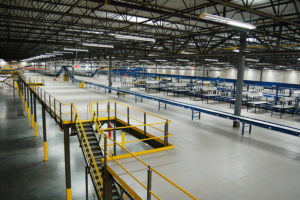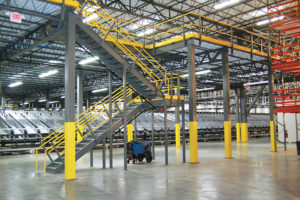Industrial Mezzanines: Supporting Fulfillment in 2021
Ecommerce giants are seeking out mezzanines to accommodate demand in the COVID-19 economy.
By Dave Milner, Contributor
In the wake up the global pandemic, the shift of consumer purchasing to online retail has accelerated. According to the U.S. Department of Commerce, fourth quarter 2020 ecommerce sales are estimated to have increased 32.1% (±2.1%) over the fourth quarter of 2019. Additionally, online spending represented 21.3% of total retail sales for the year.
With the rapid expansion of ecommerce, distribution centers and manufacturing facilities are under constant pressure to keep up with these incoming online orders. One of the largest obstacles that these facilities face is how to manage the rise in demand with their existing footprint. What happens when new machinery is required to speed up throughput, but no space for that machinery exists? When it is time to expand, is it more cost-effective to acquire new land or to build upward within the existing facility? With the dollar value of commercial buildings expected to increase by 5%, and warehouse construction leading this sector, these are the questions that are being asked.
As ecommerce giants continue to build out their logistics infrastructure, they are seeking cost-effective methods of expansion as the solution. One of these most simple and cost-effective ways these facilities are improving capacity is by installing industrial steel mezzanines.

Ecommerce giants have plenty of options when considering ways of adding or freeing up floor space; however, mezzanines have gained attention as one of the most cost-effective methods.
What is a Mezzanine?
In industrial settings, a mezzanine is an elevated floor/platform that is installed between the floor and ceiling. Typically, these are freestanding structures, bolted together with structural steel components, that can be dismantled or relocated if needed. Industrial steel mezzanines are often custom designed to satisfy the various requirements that their application calls for. They may vary widely in their square footage, column spans, decking types, capacities, number of floor levels and more. In warehouse applications, a mezzanine is typically installed for the storage of machinery, equipment, inventory or other materials to free up space at the ground level. In fulfillment centers, mezzanines may be used for storage as well, but are more commonly installed to create additional working space for personnel and machinery such as conveyor and sortation systems.
Mezzanines vs Other Expansion Methods
Ecommerce giants have plenty of options when considering ways of adding or freeing up floor space; however, mezzanines have gained attention as one of the most cost-effective methods. The reality is, permanent building floors typically require significant annual costs to maintain (e.g. HVAC, lighting, taxes). With a mezzanine, fulfillment centers can take advantage of the overhead space that they are already paying for and can do so without the high costs associated with new building construction. Additionally, since mezzanines are identified as capital equipment, they can be depreciated in seven years — offering significantly reduced taxable income over their lifetime when compared to 39-year depreciation for real property. In some states, mezzanines may even be exempt from property taxes as well. For fulfillment centers spanning hundreds of thousands of square feet, choosing between an additional floor/building expansion vs a mezzanine installation is often a multi-million-dollar decision.

With a mezzanine, fulfillment centers can take advantage of the overhead space that they are already paying for and can do so without the high costs associated with new building construction.
Mezzanine Applications for Fulfillment Centers
Warehousing and fulfillment operations are outfitted with plenty of material handling/automated systems to store, retrieve, package, scan and sort goods. Raised platforms, such as mezzanines, are often installed to support these systems and free-up floor space. Common machinery found on mezzanines in fulfillment operations include:
- Automated conveyors used to sort incoming packages
- Scanners to properly identify package dimensions
- Automatic weighing scales for package weight verification
- Sorters to batch groups of packages to be sent to smaller distribution hubs for final customer delivery
This machinery consumes a considerable amount of floor space and can span over 1,000ft. in length, but mezzanines offer the level of design flexibility required to provide a stable elevated surface for them. This creates valuable floor space below for additional operations, such as other automated systems, forklift traffic and more. Most mezzanines can be designed to accommodate obstructions such as building columns, or to meet to specific requirements such as square footage, column spans and load ratings; however, the extent of these capabilities vary by manufacturer. Other storage solutions, such as platforms supported by rack or shelving, do not offer this same level of design flexibility.
Expectations Through 2021
With the trend in ecommerce set to remain strong going into 2021, industrial steel mezzanines will continue to be identified as a strategic cost-saver for fulfillment centers that are in the planning stages of being built or in process of renovation. Their practicality and highly customizable nature make them a preferred solution for the most perplexing material handling challenges. For those looking to add floor space without unnecessary HVAC costs, and with significant tax benefits, look no further than a mezzanine. WMHS
Dave Milner is Wildeck’s Vice President of Sales. In this role, Milner is responsible for overseeing the growth of Wildeck’s distribution network and expanding the company’s reach within the material handling marketplace. Milner’s focused results-driven management style, along with his ability to lead a high-performance sales team across multiple channels, has allowed the company to sustain its position as a premier U.S. manufacturer of material handling equipment www.wildeck.com).
References
https://www2.census.gov/retail/releases/historical/ecomm/20q4.pdf
https://www.construction.com/news/dodge-data-analytics-expects-construction-starts-recover-2021
https://www.digitalcommerce360.com/article/us-ecommerce-sales/




